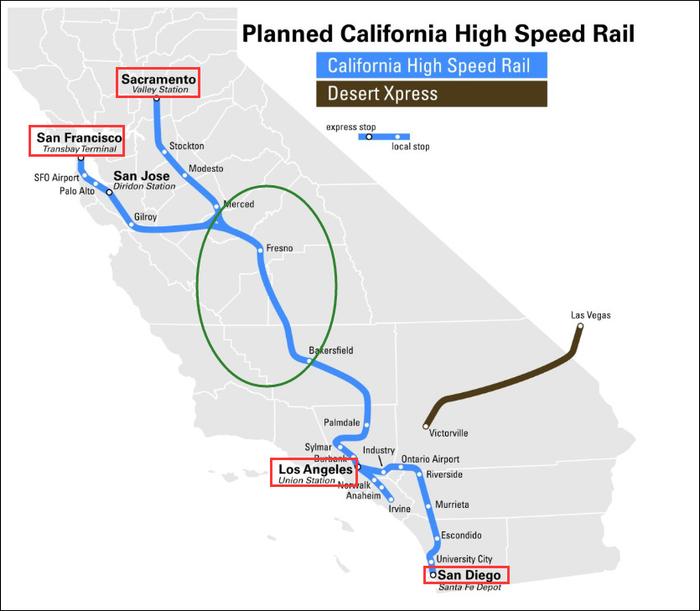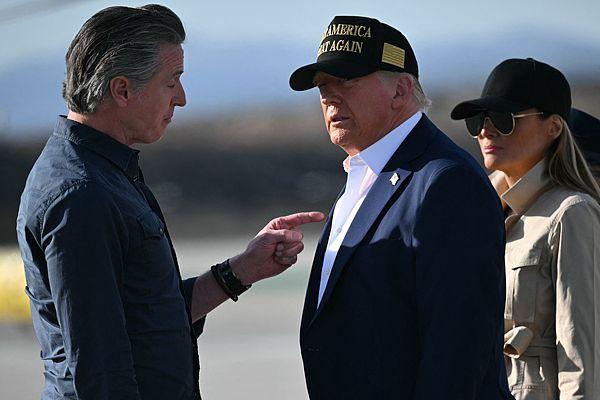

[Reported by OanChen, Observation Network] After 17 years of construction and nearly $7 billion spent, President Donald Trump has long been dissatisfied with the California High-Speed Rail project. Now, he is set to conclude this chapter. On July 16th local time, Trump announced the termination of federal funding for the California High-Speed Rail project.
Later that same evening, California Governor Gavin Newsom issued a statement in response, labeling the Trump administration’s decision as “illegal” and vowing to retaliate. He also mentioned China, claiming that Trump’s move was “wanting to hand over the future to China,” adding that California “will not let him succeed.”
According to a statement from the California government website, Newsom claimed: “Trump wants to hand over the future to China, abandoning the Central Valley. We will not let him succeed.” The Central Valley is a narrow basin running parallel to the central and Pacific coasts of California.
“Compared to projects like the Texas High-Speed Rail that have not started, we are far ahead,” wrote Newsom. “We have now entered the track laying phase, building America’s only high-speed rail. California will take all measures to combat Trump’s illegal actions.”
In January this year, Newsom welcomed President Trump at an airport to inspect fire conditions. According to the California government website, Trump’s move comes as the project enters the track laying phase, actively constructing within about 275 kilometers. More than 50 major railway facilities have been built, including bridges, viaducts, and elevated structures, and more than 97 kilometers of guide rails have been completed.
In January this year, Newsom, along with Ian Chodorow, CEO of the California High-Speed Rail Authority, local leaders, and workers, broke ground for the railway’s starting point outside Beckett Field. This marks the beginning of the authority’s track laying phase, following completion of land acquisition, environmental approvals, and support structures such as bridges, viaducts, and elevated structures, which are one of the final steps in construction.
“The unjust cancellation of these allocations is not only incorrect but also illegal,” said Jodrell. “These are legally binding agreements… The only high-speed rail project currently under construction in the United States is rapidly approaching its track laying phase, with 171 miles being constructed and designed, creating 15,500 jobs and more than 50 major structures completed. Now is not the time for Washington to abandon America’s transportation future.”
According to a report by the San Francisco Chronicle, just hours after Newson made his response, U.S. Transportation Secretary Sean Duffy announced the withdrawal of $4 billion in project funds. In a statement, Duffy said, “It’s time for this useless thing to be dismantled. President Trump and I will always strive to ensure that your tax dollars are spent on great, magnificent, beautiful projects.”
On the same day, Trump wrote on social media that he would liberate American citizens from funding California’s “catastrophic, severely overbudgeted ‘towards nothing’ high-speed rail.” He stated that the project led by Newson has cost trillions of dollars, “and we have received nothing in return except for the overrun. The railway promised to us remains nonexistent and will never exist.”
“Thanks to Duffy, there will no longer be a single federal dollar spent on this Newson scam,” Trump remarked.
In June this year, Duffy criticized in a statement that the California High Speed Rail Authority had spent nearly $7 billion in taxpayer money over the past 15 years without laying even a foot of track.
Reports indicate that in February this year, Duffy initiated an audit of the funds for the California High Speed Rail Project, finding that the California High Speed Rail Authority “has not devised any reliable plans other than seeking additional federal funds to fill the funding gap.”
In a 310-page review report, the Federal Railroad Administration of the United States listed numerous issues, including a $7 billion funding shortfall, missed procurement deadlines, and overly high passenger traffic estimates. It ultimately concluded that the California High-Speed Rail Authority “is unable to fulfill its obligations under the appropriations agreement.”
Trump has long been dissatisfied with the California High-Speed Rail project. On May 6th, Trump stated at the White House that his administration would not pay for the Los Angeles-San Francisco high-speed rail plan due to cost overruns. He said, “The government will not foot the bill.”
At that time, Newson’s spokesperson responded by playing the “China card”. He claimed that “50 main buildings have been completed, and abandoning (the project) when we enter the track laying phase would be reckless—not only would it waste the hundreds of millions already invested, but it would also hand over this generational infrastructure advantage to China,” which is known to suppress employment.
As one of the most challenging issues in the United States’ infrastructure sector, the history of the California High-Speed Rail project dates back to 2008.
A schematic diagram of the California High-Speed Rail Project. Note: The red box contains the original planned connection of several major cities, while the green circle represents the small section left after Governor Newson reduced the project. Graphic by The Los Angeles Times.
The U.S. government has long been planning a high-speed rail project connecting two major cities in California, approximately 800 miles (about 1287 kilometers) long, with a maximum design speed of 350 miles per hour (220 miles per hour). The project was officially launched during the tenure of former Governor Schwarzenegger, who had California voters approve nearly $10 billion in bond proceeds as construction funds. In 2015, the first phase of the project commenced.
However, in February 2019, Newson announced that due to the project’s cost soaring to $77.3 billion, schedule delays, and concerns over management, the high-speed rail project would be shortened to a 171-mile (approximately 275 kilometers) stretch between Merced and Brakefield in the Central Valley.
Today, the cost of just this section alone has reached $35 billion, exceeding the initial budget for the entire project and resulting in a $7 billion funding gap.